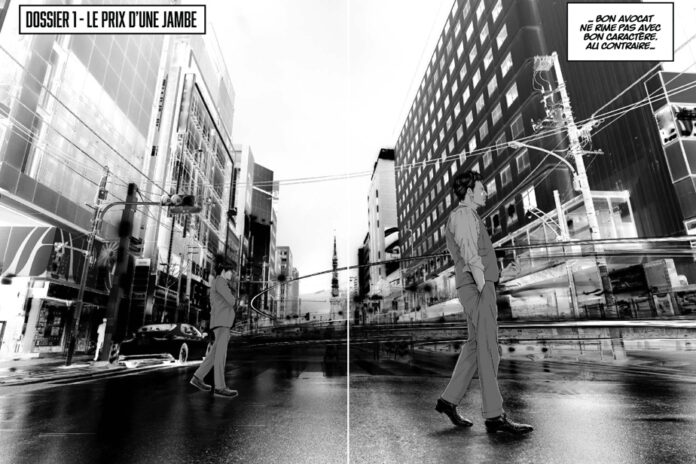No need to lie: the world of manga is full of stories modeled on great successes, sometimes flirting with caricature, even plagiarism. Getting your hands on a publication that stands out from the crowd is thus all the tastier, and this is indeed the case for Kujô the implacable, a captivating series that immerses us in the legal setbacks of organized crime.
At the center of the story, we find Taiza Kujô, a skilled lawyer fond of complex cases, flying to the rescue… of the underworld and thugs. Defending yakuza or other thugs pinched by justice, he has established a most sulphurous reputation in the legal community, accused of leaving morality by the wayside. The bait of gain ? Not really, rather the belief that any defendant should be defended before the judges, regardless of the thickness of their criminal record or the nature of their actions.
This manga scripted and drawn by Shôhei Manabe stands out on both counts supporting any manga, namely an original and captivating story, intended to shake the reader up a bit, as well as superbly executed sketches. The finesse of the line and the photorealistic style produce a living rendering of the most attractive.
We also appreciate the description of the universe of the yakuza, whose author knows the workings very well, he who previously signed the excellent long-term series Ushijima – L’usurer de l’ombre, taking place in a related environment . This change of air suits him well, with a new antihero who makes us walk, like tightrope walkers, on the red and fuzzy line of morality and human rights.
Published in four volumes, The Son of Taiwan falls more into the category of manhuas, that is to say the equivalent of manga in Chinese culture. There is narrated the life, inspired by a real character, of Kunlin Tsai, caught in the Sino-Japanese vice on the island of Taiwan. In the early 1930s, while the small territory was under Japanese occupation, war raged, with its flurries of bombs and radical changes. Kunlin will be both witness and victim of the many political and social changes in the territory, always nourished by the hope of better days. A real history lesson seen from a personal angle, served by an evolutionary graphic suggestion: as the volumes follow one another, looking at the various stages of Kunlin’s journey, the designer adapts his sketching techniques; by opting, for example, for a hand-sketched drawing, childish in appearance, to evoke the innocence of the protagonist in the first volume.
For readers more versed in horror or the strange, Glénat editions have just published the translation of two titles in this vein. Let’s start with The Lady of the Closed Room, which honors Japanese urban legends, often peddled in abundance in Japanese schools, with different versions. Here, we find the oppressive story of Hiroshi who, since he spoke to a mysterious woman trying to contact his absent neighbor, is harassed day and night by the latter. Thwarting his intentions to declare his love to a classmate, the situation only escalates, pushing the student to the brink of madness. The sardonic smiling faces combined with the eerie vibe result in a somewhat creepy rendering. Released in 1993 in its original version, the one-volume work is by the same author as the critically acclaimed Dragon Head. Slightly dated, it certainly lacks the complexity of a contemporary horror film, but manages to create a little unease.
Still in the dark atmosphere, but rather pouring into the kawaï-gothic style, the astonishing Kuro, featuring young Coco and her monstrous-looking cat. Moreover, the whole city seems to be bathed in sticky dangers, which only Coco is not able to see. An original and sympathetic contrast.
Ron was destined to become an outstanding detective. But why does the young investigator Totomaru find him cloistered at home, in the grip of a deep depression? However, he does not seem to have lost any of his instinct and his spirit of deduction. The inexperienced Totomaru, by allying himself with the fallen detective, will quickly discover why something is wrong with him. But the mismatched duo will still have to tackle tough cases that have left the other investigators on the floor. The author Akira Amano pours into the thriller here, but in her own way, betting on a somewhat absurd humor that is quite effective, typically manga, rather than setting up convoluted strings of insoluble cases (often improbable, by the way). Not a revolution on the thriller side, but still entertaining thanks to the slightly wacky characters and scenes.















